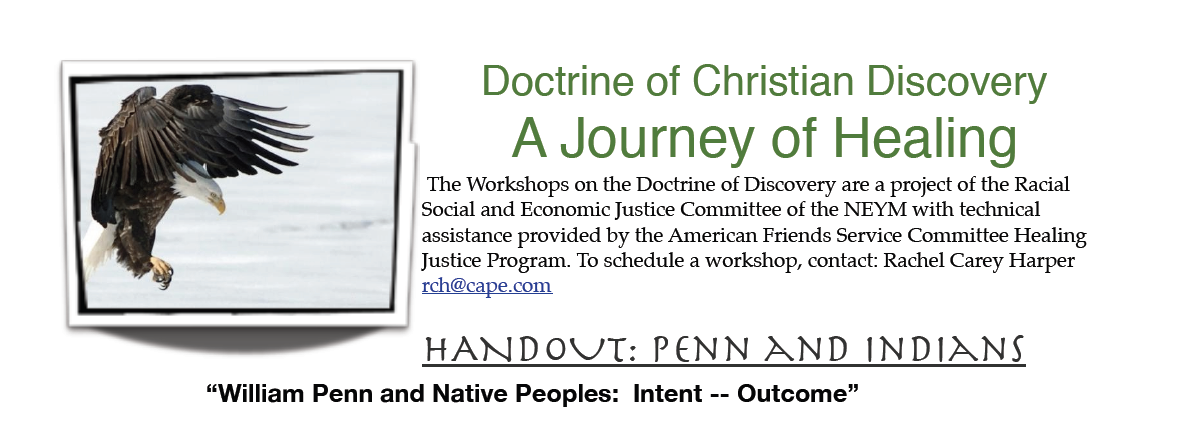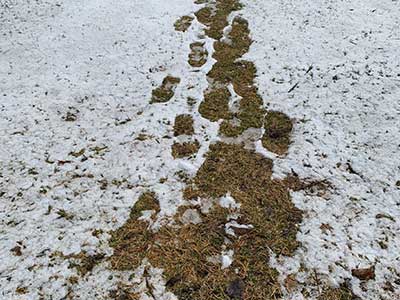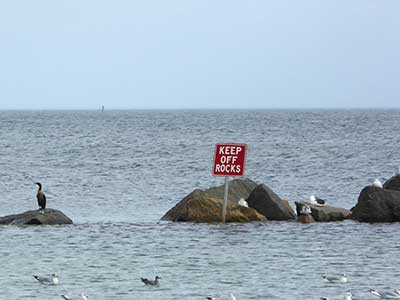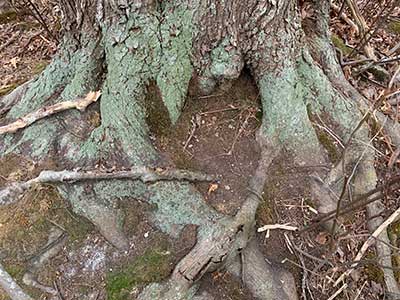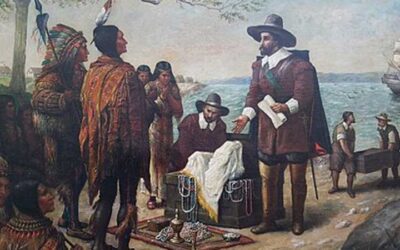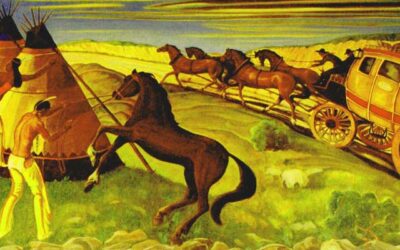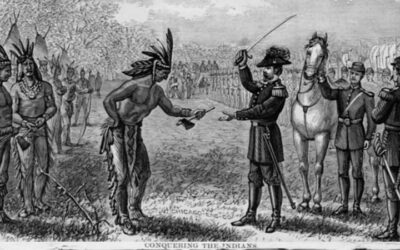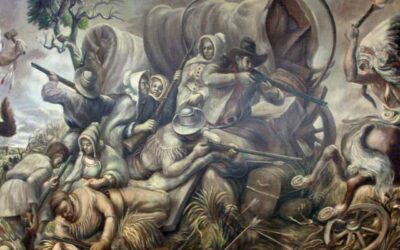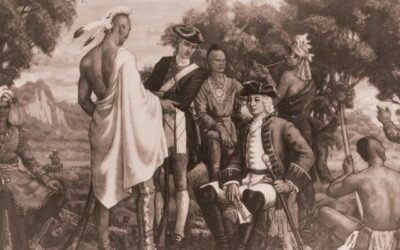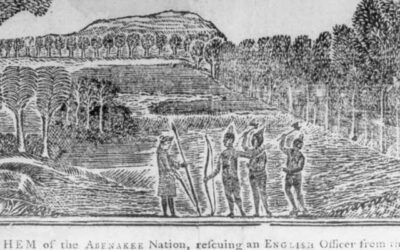
Legal Genocide
The Doctrine of Christian Discovery impacted every aspect of the US governance including in legal documents from the constitution though to today (see Foundational Genocide section for a description of the Doctrine of Discovery).
“He has excited domestic insurrections amongst us, and has endeavoured to bring on the inhabitants of our frontiers, the merciless Indian Savages, whose known rule of warfare, is an undistinguished destruction of all ages, sexes and conditions.” The US Declaration of Independence signed July 4, 1776
Important legal case pertaining to the Doctrine of Discovery:
- 1823 — In the Johnson v. McIntosh case, U.S. Chief Justice John Marshall blatantly inserts language of “discovery” based on the bull Inter Caetera into the decision.
- 1831 — In Cherokee v. Georgia, Justice Marshall rules that the Cherokee Nation was not a “foreign state” as defined in the U.S. Constitution, and therefore they could not sue the state of Georgia in the Supreme Court from usurping the gold on their land.
- 1978 the decisions in Oliphant v. Suquamish Indian Tribe and
- 1990 — Duro v. Reina used the doctrine to prohibit tribes from criminally prosecuting first non-Indians, then Indians who were not a member of the prosecuting tribe.
- 2005 — City of Sherrill v. Oneida Indian Nation of New York. Writing for the majority, Ruth Bader Ginsburg stated that “Under the ‘doctrine of discovery…’ fee title [ownership] to the lands occupied by Indians when the colonists arrived became vested in the sovereign—first the discovering European nation and later the original states and the United States.
Actions to recind the Papal Bulls:
- 1992 – A formal movement to revoke the bull Inter Caetera is initiated by the Indigenous Law Institute based in the United States.
- 1993 – At the Parliament of the World’s Religions in Chicago, Illinois, sixty indigenous delegates draft a Declaration of Vision calling for the revocation of the bull Inter Caetera
- OCTOBER 12, 1997 – An annual papal bulls burning commenced in Honolulu, Hawai’i calling international attention to the papal bulls issue.
- OCTOBER 12, 1998 – Over 50 indigenous and human rights advocates gather in Honolulu to demand the revocation of the bull Inter Caetera, and called for it to be revoked by the year 2,000, or by the beginning of the “new millennium”.
- NOVEMBER 28, 1998 – Pope John Paul II called “Christianity’s 2,000 anniversary a year of mercy,” as reported by AP, saying “the church will seek forgiveness,” “atonement,” and that he “wants the church to enter the third millennium with a clear conscience.”
- FEBRUARY 19, 1999 – The United Church of Christ, Hawai’i Conference, passes a resolution which resolves that: “President Paul Sherry on behalf of the United Church of Christ urges and calls upon people of conscience in the Roman Catholic hierarchy and in other organized religions to persuade Pope John Paul II to revoke the Papal Bulls Dum Diversas of 1452 [Romanus Pontifex of 1455] and Inter Caetera of 1493 by the year 2,000.”
- MAY 1999 – At the international Hague Appeal for Peace conference, Tony Castanha (Carib/Boricua) and Steve Newcomb (Shawnee/Lenape) directly address and call for the revocation of the bull Inter Caetera on both “Interfaith” and “Root Causes of War/Culture of Peace” panel presentations.
- OCTOBER 2000 – Indigenous Peoples’ Delegation (nine delegates) converge on Italy and the Vatican advocating for the revocation of Inter Caetera. Delegates meet with official from the Pontifical Council for Justice and Peace.
- 2001 – Pontifical Historical Commission studies the issue for the first time and rules that “Inter Caetera is no longer juridically valid.” Kosmos Indigena founded. Continues to call on the Vatican to revoke Inter Caetera if it is no longer juridically valid.
- OCTOBER 2003 – Seventh annual papal bulls burning observed in Honolulu, Hawai‘i, as well as other locations around the world. Call is made to return to Rome in October 2005.
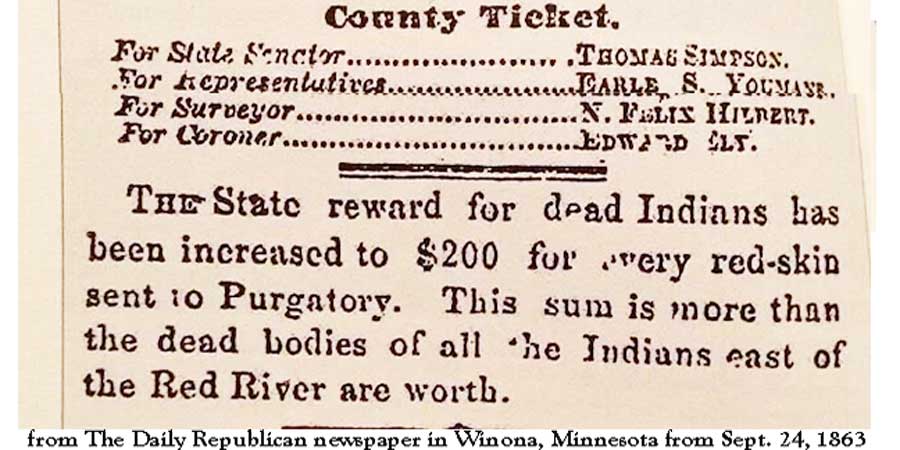
SEE Appendix C: Massachusetts Indian Scalp Bounties from [Massachusetts], Acts and Resolves, Public and Private, of the Province of the Massachusetts Bay , vols. 1-13 (Boston: Wright & Potter, 1869-1920).
GRIM COMMERCE: SCALPS, BOUNTIES,
AND THE TRANSFORMATION OF TROPHY-TAKING IN THE EARLY AMERICAN NORTHEAST, 1450-1770
A thesis by Margaret H. Roosevelt Sewall Ball
“Europeans had mutilated their dead often as a sign of state power, epitomized by the practice of drawing and quartering an English traitor. On this side of the Atlantic, communities displayed and exchanged scalps, hands and other trophies as symbols of alliance. Many performed elaborate ceremonies intended to incorporate these items as surrogates for the slain, ritually reviled them as vengeance against the dead, or both Colonial interactions transformed these expressions into a language expressing economic relationships, domination, and cultural resistance. …
The violent conflict in New England, while reinforcing cultural exclusionism, did not end cultural interaction; instead it became the essential mechanism for that interaction. “Over time, mutual bloodshed and brutality evolved to constitute a shared language of praxis” that fused with nascent English racial idioms to fuel Indian-hating and the trophy-taking practices to epitomize anti-Indian violence.8 The bounty system, initiated by the Dutch and elaborated by New Englanders, made this connection “agonizingly concrete,””
Broken Treaties
According to Wikipedia, from 1778 to 1904, the United States government entered into more than 500 treaties with the Native American tribes; all of these treaties have since been violated in some way or outright broken by the US government, Native Americans and First Nations peoples are still fighting for their treaty rights in federal courts and at the United Nations. Click here for the full list.
Navi Pillay, the U.N. High Commissioner for Human Rights, issued a statement August 7 [2013] to mark International Day of the World’s Indigenous Peoples on August 9. … The High Commissioner said that exploitation of Indigenous Peoples and expropriation of their lands and resources continue today and “underscore the need to do more to protect the rights of the estimated 370 million indigenous people worldwide.” …
The spiritual aspect of treaty-making escaped the United States government, history tells us. The U.S. federal government entered into more than 500 treaties with Indian nations from 1778 to 1871; every one of them was “broken, changed or nullified when it served the government’s interests,” Helen Oliff wrote in “Treaties Made, Treaties Broken.”

From Wikipedia:
The lands to the east would belong to Portugal and the lands to the west to Castile. The treaty was signed by Spain, 2 July 1494, and by Portugal, 5 September 1494. The other side of the world was divided a few decades later by the Treaty of Zaragoza, signed on 22 April 1529, which specified the antimeridian to the line of demarcation specified in the Treaty of Tordesillas. Originals of both treaties are kept at the General Archive of the Indies in Spain and at the Torre do Tombo National Archive in Portugal.[8]
Despite considerable ignorance regarding the geography of the so-called New World, Portugal and Spain largely respected the treaty. The other European powers however did not sign the treaty and generally ignored it, particularly those that became Protestant after the Reformation. Similarly, the Indigenous nations did not acknowledge the treaty, and as the legal foundation for the Discovery Doctrine,[9] it has been a source of ongoing tension regarding land ownership into modern times, cited as recently as the 2005 United States Supreme Court case Sherrill v. Oneida Nation.
Nation to Nation: Treaties Between the United States and American Indian Nations
Treaties made by the United States with Indian Nations inscribe solemn vows that cannot lightly be broken or ignored, a verity that Supreme Court Justice Hugo Black recognized in 1960 , “Great nations, like great men, should keep their word.”
Treaties Between the United States and Native Americans
The full list of Treaties Between the United States and Native Americans from 1778 — 1868 is available from the Avalon Project which mounts digital documents relevant to the fields of Law, History, Economics, Politics, Diplomacy and Government.
Broken treaties remain among America’s deepest and darkest secrets
by Tim Giago (Nanwica Kciji- Stands Up For Them) The full article is here… Excerpt from the article… The treaty making process between the Indian nations and the United States of America was stopped shortly after the huge treaty meeting that took place at Fort Laramie...
Broken treaties with Native Americans not fixed by Supreme Court ruling
by TERRY L. ANDERSON AND ADAM CREPELLE | 07/16/20 The full article is here… Excerpt from the article… On July 9, 2020, The U.S. Supreme Court handed down its decision McGirt v. Oklahoma, a case to determine whether Oklahoma or the federal government had jurisdiction...
Broken Treaties With Native American Tribes: Timeline
by SARAH PRUITT |NOV 10, 2020 The full article is here… Excerpt from the article… From 1778 to 1871, the United States signed some 368 treaties with various Indigenous people across the North American continent. Concluded during the nearly 100-year period from the...
The Treaty That Forced the Cherokee People from Their Homelands Goes on View
by Dennis Zotigh | April 24th, 2019 The full article is here… Excerpt from the article… N egotiated in 1835 by a minority party of Cherokees, challenged by the majority of the Cherokee people and their elected government, the Treaty of New Echota was used by the...
See : HANDOUT: Penn and Indians
